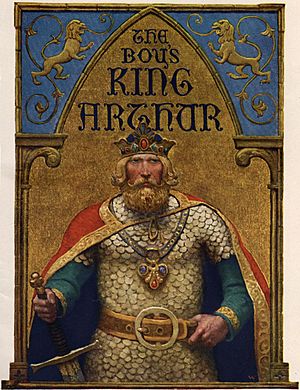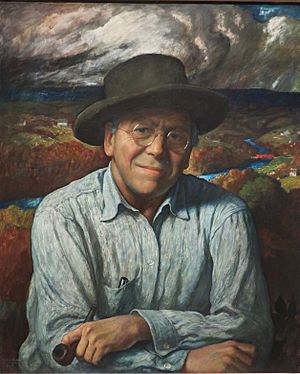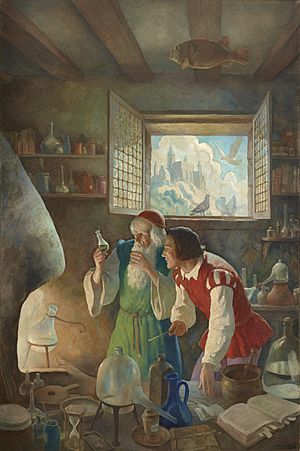N. C. Wyeth facts for kids
Quick facts for kids
N. C. Wyeth
|
|
|---|---|
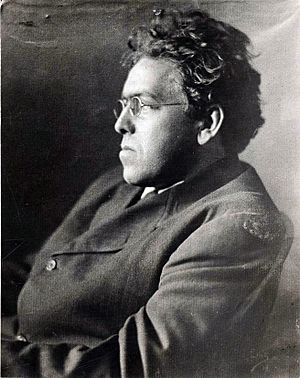
N. C. Wyeth, c. 1920
|
|
| Born |
Newell Convers Wyeth
October 22, 1882 Needham, Massachusetts, United States
|
| Died | October 19, 1945 (aged 62) Chadds Ford, Pennsylvania, United States
|
| Known for | Illustration, painting |
|
Notable work
|
Treasure Island Robinson Crusoe |
| Style | Brandywine School |
| Movement | Realism, Romanticism |
| Spouse(s) |
Carolyn Brenneman Bockius of Wilmington
(m. 1906) |
Newell Convers Wyeth (born October 22, 1882 – died October 19, 1945), known as N. C. Wyeth, was a famous American painter and illustrator. He learned from the well-known artist Howard Pyle and became one of America's best illustrators. Wyeth created over 3,000 paintings and illustrated 112 books. He is most famous for the 25 books he illustrated for Scribner's, known as the Scribner Classics.
His first big success was illustrating Treasure Island. The money he earned from this book helped him pay for his art studio. Wyeth was a realist painter. This means he painted things as they looked in real life. His illustrations were made to be understood quickly. He knew that painting and illustrating were different, saying in 1908 that they "cannot be mixed."
N. C. Wyeth was the father of Andrew Wyeth and the grandfather of Jamie Wyeth. Both Andrew and Jamie also became famous American painters.
Contents
Wyeth's Early Life and Art
N. C. Wyeth was born in 1882 in Massachusetts. His parents were Andrew Newell Wyeth II and Henriette Zirngiebel Wyeth. His family had a long history in America, with ancestors who fought in many wars. These family stories gave Wyeth ideas for his art. His mother's family came from Switzerland. She knew famous writers like Henry David Thoreau and Henry Wadsworth Longfellow. Wyeth likely got his love for books and art from his mother.
He was the oldest of four brothers. They spent a lot of time outdoors, hunting, fishing, and working on their farm. These activities helped him make his illustrations feel real. He once said, "When I paint a figure on horseback... I have an acute sense of the muscle strain." This meant he understood how bodies moved and felt.
His mother encouraged his art from a young age. By age twelve, Wyeth was already good at watercolor painting. He studied art at several schools, including the Massachusetts Normal Art School. His painting teacher there told him to become an illustrator.
Becoming a Famous Illustrator
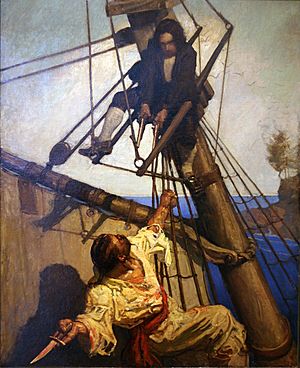
Wyeth traveled to the Brandywine Valley to study with Howard Pyle. He later made his home in Chadds Ford, Pennsylvania. His first big job as an illustrator was a picture of a bucking bronco for the cover of The Saturday Evening Post in 1903. This was amazing for a twenty-year-old artist who had only studied with Pyle for a few months.
In 1904, the same magazine asked him to illustrate a Western story. Pyle told Wyeth to go West to see things for himself. Wyeth worked as a cowboy in Colorado, moving cattle and doing ranch chores. He also visited the Navajo people in Arizona and New Mexico. This helped him understand Native American culture. When his money was stolen, he worked as a mail carrier to earn enough to get home. He loved the West, writing home, "The life is wonderful, strange... it seems to whisper, 'Come back, you belong here.'"
He took a second trip two years later. He gathered more information about mining and brought back cowboy and Native American clothes. These trips inspired many of his early paintings of cowboys and Native Americans. These pictures showed the exciting life of the Old West.
After returning to Chadds Ford, he painted farm scenes for Scribner's. He found the local landscape beautiful, even if it was less dramatic than the West. His painting Mowing (1907) was a very successful picture of country life.
Family Life and Artworks
In 1906, Wyeth married Carolyn Brenneman Bockius. In 1908, they moved to Chadds Ford, Pennsylvania. They had five talented children: Andrew Wyeth, Henriette Wyeth Hurd, Carolyn Wyeth, Ann Wyeth McCoy, and Nathaniel C. Wyeth. Their home was a lively place, with frequent visitors like famous writers and actors.
Andrew Wyeth, who spent a lot of time with his father because he was often sick, said his father was strict but patient. N. C. Wyeth's hard work as an illustrator allowed his children to follow their own dreams in art and science.
- Andrew became one of the most important American painters of his time.
- Henriette and Carolyn also became painters.
- Ann became a painter and a composer.
- Nathaniel became an engineer for DuPont. He helped invent the plastic soda bottle.
By 1911, Wyeth started illustrating classic books. He created a series of paintings for Treasure Island (1911) by Robert Louis Stevenson. Many people think these are his best illustrations. This work made him famous and helped him buy his house and studio. He also illustrated many other famous books, including:
- Kidnapped (1913)
- Robin Hood (1917)
- The Last of the Mohicans (1919)
- Robinson Crusoe (1920)
- Rip Van Winkle (1921)
- The White Company (1922)
- The Yearling (1939)
He also created art for popular magazines like Century and Harper's Monthly.
By 1914, Wyeth felt unhappy about how commercial his work had become. He felt that illustrating for money made him compromise his artistic vision. He said that illustrations had to be practical for printers, which "kills that underlying inspiration to create thought."
Wyeth also designed posters, calendars, and advertisements for companies like Lucky Strike and Coca-Cola. He painted murals, which are large wall paintings, for banks and other public buildings. During World War I and II, he made patriotic images for the government.
His other paintings, like portraits and landscapes, changed over time. He tried different styles, including Impressionism in the 1910s. Later, in the 1930s, he moved towards a realistic American style. He often worked quickly and experimented a lot. He could even sketch and paint a large picture in just three hours.
Wyeth's Legacy
In June 1945, Wyeth received an honorary degree from Bowdoin College. He was a member of many art groups, including the National Academy.
In October 1945, Wyeth and his grandson were in a car accident near his home in Chadds Ford. They both passed away. At the time, Wyeth was working on a large series of murals for the Metropolitan Life Insurance Company. His son Andrew Wyeth and son-in-law John McCoy finished these murals.
You can see many of Wyeth's works at the Brandywine River Museum in Chadds Ford, Pennsylvania. There are also collections at the Portland Museum of Art and the Farnsworth Art Museum in Maine. You can even tour the N. C. Wyeth House and Studio in Chadds Ford. His studio is kept just as he left it, with his paint palette next to his last painting. His home and studio were named a National Historic Landmark in 1997.
Other Works by N. C. Wyeth
- Mowing (1907)
- Long John Silver and Hawkins (1911)
- The Long Roll (1911)
- The Great Train Robbery (1912)
- Cease Firing (1912)
- The Sampo: A Wonder Tale of the North (1912)
- The Fence Builders (1915)
- The Mysterious Stranger (1916)
- The Scottish Chiefs (1921) by Jane Porter
- Stand and Deliver (1921)
- Rip Van Winkle (1921)
- The Giant (1922)
- Drums (1925) by James Boyd
- The Deerslayer (Scribners, 1925) by James Fenimore Cooper
- Reception to Washington on April 21, 1789, at Trenton on his way to New York to Assume the Duties of the Presidency of the United States (1930)
- Apotheosis of the Family (1932): a large mural in Wilmington, Delaware
- Dying Winter (1934)
- Men of Concord and some others as portrayed in the Journal of Henry David Thoreau (1936)
- The Alchemist (1937)
- They Took Their Wives with Them on Their Cruises (1938)
- Deep Cove Lobsterman (1939)
- The War Letter (1944)
- Nightfall (1945)
Images for kids
-
The Saturday Evening Post, cover illustration, December 9, 1905
See also
- Brandywine School
- National Museum of American Illustration
- Wyeth



